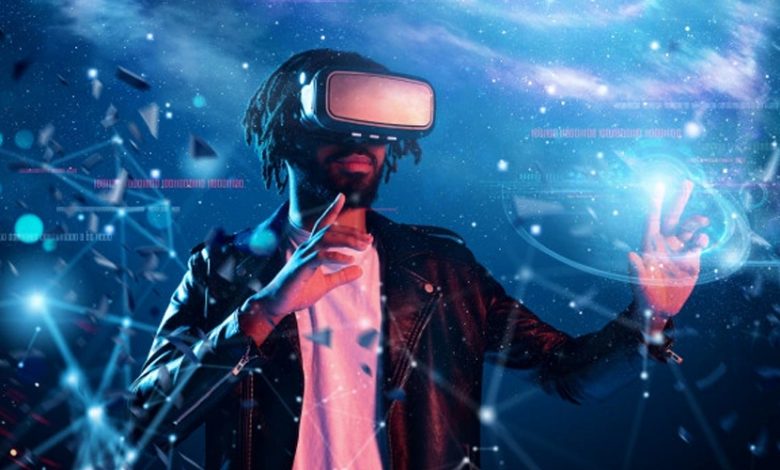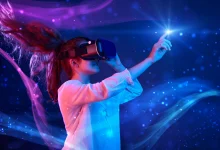Augmented Reality Gaming
Augmented Reality Gaming: Bridging the Gap Between Virtual and Real Worlds

Introduction:
Augmented reality (AR) gaming represents a thrilling convergence of technology and imagination, offering players the opportunity to immerse themselves in interactive virtual worlds overlaid onto the real world. With the rise of powerful mobile devices and innovative AR platforms, such as augmented reality glasses and headsets, AR gaming has emerged as a dynamic and rapidly evolving genre within the gaming industry. In this exploration, we’ll delve into the fascinating world of augmented reality gaming, examining its origins, technological underpinnings, and potential impact on the future of gaming.
Origins and Evolution:
The roots of augmented reality gaming can be traced back to the early 2000s, with the release of games like “ARQuake” and “Mobotag.” These pioneering titles experimented with the concept of overlaying virtual elements onto the real world using early AR technologies. However, it wasn’t until the advent of smartphones equipped with GPS, cameras, and motion sensors that AR gaming truly began to take off. Games like “Ingress” and “Pokémon GO” introduced millions of players to the possibilities of AR gaming, allowing them to explore their surroundings and interact with virtual characters and objects in real-time.
Origins and Evolution of Augmented Reality Gaming: A Journey Through Innovation
Introduction:
Augmented Reality (AR) gaming has emerged as a captivating fusion of digital and physical worlds, allowing players to interact with virtual elements superimposed onto their real-world surroundings. The evolution of AR gaming is a testament to the relentless pursuit of technological innovation and creative experimentation. In this exploration, we’ll delve into the origins of AR gaming, trace its evolutionary path, and examine the key milestones that have shaped this dynamic genre of gaming.
Origins of Augmented Reality Gaming:
The concept of augmented reality dates back several decades, but its integration into gaming began to take shape in the early 2000s. One of the earliest examples of AR gaming was “ARQuake,” a modification of the popular first-person shooter “Quake” that enabled players to experience the game in real-world environments using wearable AR gear. This pioneering experiment laid the groundwork for future developments in AR gaming and showcased the potential of blending virtual and physical realities.
The Evolution Begins:
The evolution of AR gaming gained momentum with the advent of smartphones equipped with advanced sensors and cameras. In 2009, the release of “Layar,” an AR app that overlaid digital information onto the camera feed of a smartphone, marked a significant milestone in the popularization of AR technology. Soon after, games like “Parallel Kingdom” and “Ingress” introduced players to the concept of location-based AR gaming, where virtual elements were tied to real-world geographic locations, encouraging players to explore their surroundings.
Pokémon GO: A Game-Changer:
The true breakthrough moment for AR gaming came with the release of “Pokémon GO” in 2016. Developed by Niantic, the game leveraged the GPS capabilities of smartphones to create an immersive AR experience where players could capture Pokémon creatures in real-world locations. “Pokémon GO” became a global phenomenon, attracting millions of players and sparking widespread interest in AR gaming. Its success demonstrated the mass appeal of AR gaming and paved the way for future developments in the genre.
Advancements in AR Technology:
The evolution of AR gaming has been driven by advancements in AR technology, particularly in the areas of computer vision, spatial mapping, and wearable devices. AR platforms such as Apple’s ARKit and Google’s ARCore have made it easier than ever for developers to create AR experiences for mobile devices, while devices like Microsoft’s HoloLens and Magic Leap’s augmented reality glasses have pushed the boundaries of what’s possible in AR gaming.
New Horizons: From Mobile to Wearables:
As AR technology continues to evolve, we’re witnessing a shift from mobile-based AR gaming to more immersive experiences enabled by wearable devices. AR glasses and headsets offer a hands-free, immersive gaming experience that blurs the lines between the virtual and physical worlds. Games like “Minecraft Earth” and “Harry Potter: Wizards Unite” are pioneering this new frontier of AR gaming, offering players the opportunity to explore and interact with virtual worlds in ways previously unimaginable.
The Future of AR Gaming:
Looking ahead, the future of AR gaming holds boundless possibilities. As AR hardware becomes more advanced and accessible, we can expect to see a proliferation of innovative AR games that push the boundaries of creativity and immersion. From narrative-driven experiences to collaborative multiplayer adventures and beyond, AR gaming has the potential to transform the way we play and experience games, ushering in a new era of interactive entertainment.
Conclusion:
In conclusion, the origins and evolution of augmented reality gaming represent a fascinating journey of innovation, experimentation, and technological advancement. From its humble beginnings with early experiments like “ARQuake” to the global phenomenon of “Pokémon GO” and beyond, AR gaming has captivated players with its ability to blend virtual and physical realities in new and exciting ways. As we continue to explore the possibilities of AR technology, one thing is clear: the future of gaming is bright, and augmented reality will play a central role in shaping it.
Technological Underpinnings:
At its core, augmented reality gaming relies on a combination of hardware and software technologies to create immersive virtual experiences. Mobile devices equipped with cameras, GPS, accelerometers, and gyroscopes serve as the primary interface for AR gaming, allowing players to view and interact with virtual elements overlaid onto the real world. Advanced computer vision algorithms and image recognition technologies enable devices to recognize and track objects in the environment, facilitating the seamless integration of virtual content into real-world settings.
Exploring the Technological Underpinnings of Augmented Reality Gaming
Introduction:
Augmented Reality (AR) gaming has emerged as a revolutionary force in the gaming industry, blending virtual elements seamlessly with the real world. Unlike Virtual Reality (VR), which immerses users in a completely digital environment, AR overlays virtual objects onto the physical world, enhancing the gaming experience. The success of AR gaming hinges on a complex interplay of various technological components that work together to create immersive and interactive gameplay. In this exploration, we delve into the technological underpinnings that drive the evolution and advancement of AR gaming.
Hardware:
Smartphones:
The widespread adoption of smartphones equipped with advanced sensors such as accelerometers, gyroscopes, and GPS has democratized AR gaming. These sensors enable precise tracking of a user’s location, orientation, and movement, forming the foundation for AR experiences.
Wearable Devices:
Innovations like AR glasses and headsets offer hands-free AR interactions, providing users with a more immersive and natural gaming experience. These devices leverage optics, displays, and sensors to overlay digital content onto the user’s field of view, creating a seamless blend of virtual and real-world elements.
Haptic Feedback Systems:
Haptic feedback devices enhance immersion by providing tactile sensations that correspond to in-game events. Vibrations, force feedback, and motion simulation technologies simulate the sense of touch, making AR gaming more engaging and immersive.
Software:
Computer Vision:
Computer vision algorithms analyze real-world imagery captured by device cameras to identify objects, surfaces, and spatial features. This enables AR applications to understand and interact with the user’s environment, facilitating the placement of virtual objects in physical space.
Simultaneous Localization and Mapping (SLAM):
SLAM algorithms enable devices to create and update a map of their surroundings in real-time while tracking their own position within that map. This technology is crucial for AR gaming as it allows virtual objects to persistently anchor to the physical world, maintaining spatial coherence and continuity.
Augmented Reality SDKs:
Software Development Kits (SDKs) like ARKit (iOS) and ARCore (Android) provide developers with tools and frameworks to create AR experiences for mobile devices. These SDKs abstract the complexities of AR technology, offering features such as motion tracking, environmental understanding, and light estimation, thereby empowering developers to focus on creating compelling gameplay experiences.
Networking:
Multiplayer AR:
Network technologies enable synchronous multiplayer AR experiences, allowing multiple users to interact and collaborate in the same augmented environment. This requires low-latency communication and synchronization mechanisms to ensure smooth and responsive gameplay across distributed devices.
Cloud Computing:
Leveraging cloud infrastructure can offload computationally intensive tasks such as scene processing and object recognition, enabling AR applications to run smoothly on resource-constrained devices. Cloud-based solutions also facilitate the delivery of dynamic content updates and live interactions in AR gaming environments.
Content Creation Tools:
3D Modeling and Animation Software:
Content creation tools enable developers to design and animate virtual objects, characters, and environments for AR gaming. Integration with AR development platforms allows creators to preview and test their content in real-world scenarios, ensuring optimal visual fidelity and spatial alignment.
User-generated Content Platforms:
User-generated content platforms empower players to contribute their own creations to the AR gaming ecosystem, fostering community engagement and creativity. By enabling user-generated content creation and sharing, these platforms enrich the diversity and longevity of AR gaming experiences.
Artificial Intelligence:
Adaptive Gameplay:
AI algorithms can analyze player behavior and preferences to dynamically adjust game mechanics, difficulty levels, and content delivery in real-time. This personalization enhances player engagement and retention, making AR gaming experiences more immersive and enjoyable.
Natural Language Processing (NLP):
NLP technologies enable natural language interactions between players and virtual characters or assistants within AR games. Voice commands, dialogue systems, and language understanding capabilities enhance the realism and interactivity of AR gaming experiences, blurring the line between fiction and reality.
Conclusion:
The technological underpinnings of augmented reality gaming represent a convergence of hardware innovation, software development, networking infrastructure, content creation tools, and artificial intelligence. As these technologies continue to advance and evolve, AR gaming promises to redefine the boundaries of immersive entertainment, offering players unparalleled experiences that seamlessly blend the virtual and physical worlds. By understanding and leveraging these technological foundations, developers can unlock new dimensions of creativity and engagement, shaping the future of gaming in the augmented realm.
Key Features and Gameplay Mechanics:
Augmented reality gaming offers a wide range of features and gameplay mechanics that set it apart from traditional gaming experiences. One of the defining characteristics of AR gaming is its emphasis on location-based gameplay, which encourages players to explore their surroundings and interact with virtual elements scattered throughout the real world. Games like “Pokémon GO” use GPS data to populate the game world with virtual creatures and landmarks, encouraging players to venture outside and discover new locations. Another key feature of AR gaming is its ability to promote social interaction and collaboration among players. Many AR games incorporate multiplayer modes that allow players to team up with friends or compete against each other in real-time battles and challenges. This social aspect adds an extra layer of excitement and engagement to the gaming experience, fostering a sense of community and camaraderie among players.
Exploring Key Features and Gameplay Mechanics in Augmented Reality Gaming
Introduction:
Augmented Reality (AR) gaming represents a dynamic fusion of virtual content with real-world environments, offering players immersive and interactive experiences that extend beyond traditional gaming boundaries. The success of AR games often hinges on their ability to leverage unique features and gameplay mechanics that capitalize on the capabilities of AR technology. In this exploration, we delve into the key features and gameplay mechanics that define the landscape of augmented reality gaming.
Environmental Interaction:
Object Recognition:
AR games can utilize object recognition technology to identify real-world objects and incorporate them into gameplay. Players may interact with physical objects as game elements, unlocking hidden content or triggering events by scanning or interacting with specific items.
Environmental Mapping:
By leveraging spatial mapping and tracking capabilities, AR games can transform the player’s surroundings into dynamic gaming environments. Players navigate physical spaces to complete objectives, uncover secrets, and engage with virtual elements seamlessly integrated into the real world.
Real-time Spatial Anchoring:
Persistent AR:
One of the defining features of AR gaming is the ability to anchor virtual objects in real-world locations persistently. Players can place virtual structures, characters, or items in their environment, and these elements remain anchored in place even after leaving and returning to the same location, providing continuity and immersion.
Spatial Recognition:
AR games can recognize and utilize spatial features such as surfaces, landmarks, and geographic locations to generate contextually relevant gameplay experiences. This enables location-based gameplay mechanics, such as scavenger hunts, geocaching, or territorial control games that leverage real-world geography and landmarks.
Social Interaction:
Multiplayer Collaboration:
AR games can facilitate collaborative multiplayer experiences, allowing players to interact and cooperate in shared augmented environments. Players can team up to solve puzzles, conquer challenges, or engage in competitive gameplay, fostering social interaction and camaraderie.
Social Integration:
Integration with social media platforms enables players to share their AR gaming experiences with friends and followers, fostering community engagement and viral adoption. Features such as shared experiences, leaderboards, and collaborative challenges enhance the social aspect of AR gaming, encouraging players to connect and compete with others.
Physical Movement and Gestures:
Motion-based Gameplay:
AR games often encourage physical movement and gestures as integral gameplay mechanics. Players may need to walk, run, jump, or perform specific actions to navigate environments, interact with objects, or trigger in-game events, promoting physical activity and immersion.
Gesture Recognition:
Advanced gesture recognition technology enables AR games to interpret hand movements, gestures, and body language as input commands. Players can cast spells, manipulate objects, or perform actions using intuitive gestures, enhancing immersion and interactivity.
Mixed Reality Elements:
Virtual Object Integration:
AR games can seamlessly integrate virtual objects into the player’s real-world environment, allowing for dynamic interactions and realistic physics simulations. Players can manipulate virtual objects, build structures, or engage in virtual combat within their physical surroundings, blurring the line between reality and fantasy.
Augmented Audio:
Audio augmentation enhances the immersive experience of AR gaming by providing spatialized sound effects, environmental ambience, and dynamic music that react to the player’s actions and surroundings. Immersive audio cues enrich gameplay feedback and situational awareness, heightening immersion and engagement.
Conclusion:
Augmented reality gaming offers a rich tapestry of features and gameplay mechanics that leverage the unique capabilities of AR technology to create immersive, interactive, and socially engaging experiences. From environmental interaction and spatial anchoring to social integration and mixed reality elements, AR games redefine the boundaries of gaming by seamlessly blending virtual content with real-world environments. By embracing these key features and gameplay mechanics, developers can unlock new dimensions of creativity and player engagement, shaping the future of gaming in the augmented realm.
Potential Impact and Future Directions:
The potential impact of augmented reality gaming on the future of gaming is immense, with experts predicting that AR technology could revolutionize the way we play, socialize, and interact with our environment. As AR hardware becomes more advanced and widespread, we can expect to see a proliferation of innovative AR games that blur the lines between the virtual and real worlds. From immersive storytelling experiences to location-based adventures and beyond, the possibilities for AR gaming are limited only by the imagination of game developers and players alike.
Unveiling the Potential Impact and Future Directions of Augmented Reality Gaming
Introduction:
Augmented Reality (AR) gaming has emerged as a transformative force in the gaming industry, promising immersive, interactive experiences that blend virtual content with the real world. As AR technology continues to evolve, its potential impact on entertainment, education, social interaction, and various other domains becomes increasingly profound. In this exploration, we unveil the potential impact and speculate on future directions of augmented reality gaming, shedding light on its transformative power and the possibilities it holds for the future.
Entertainment:
Immersive Experiences:
AR gaming offers players unprecedented levels of immersion by seamlessly integrating virtual elements into their real-world surroundings. This immersion opens the door to captivating storytelling, engaging gameplay mechanics, and interactive experiences that transcend traditional gaming boundaries.
Spatial Exploration:
AR games enable players to explore physical spaces in new and exciting ways, transforming mundane environments into dynamic gaming landscapes. From urban exploration to outdoor adventures, AR gaming encourages players to rediscover their surroundings and engage with them in novel ways.
Education and Learning:
Experiential Learning:
AR gaming presents opportunities for experiential learning by providing hands-on, interactive experiences that facilitate knowledge acquisition and skill development. Educational AR games can simulate scientific phenomena, historical events, or cultural heritage sites, offering immersive learning experiences that engage and inspire learners of all ages.
Gamified Learning:
Integrating educational content with game mechanics makes learning more engaging and enjoyable. AR games can gamify educational experiences by rewarding players for completing challenges, mastering concepts, or collaborating with others, fostering a love for learning and encouraging self-directed exploration.
Social Interaction:
Shared Experiences:
Multiplayer AR gaming fosters social interaction by enabling players to share immersive experiences in real-time. Whether collaborating on missions, competing in challenges, or simply exploring virtual worlds together, AR games provide opportunities for social bonding and collaborative play.
Augmented Social Networking:
AR technology can enhance social networking by overlaying digital information, profiles, and interactions onto the physical world. AR-enabled social networks could facilitate real-world connections, networking opportunities, and shared experiences, blurring the line between virtual and physical social interactions.
Health and Wellness:
Physical Activity:
AR games encourage physical activity by motivating players to move, explore, and interact with their surroundings. From outdoor adventures to fitness challenges, AR gaming promotes active lifestyles and helps combat sedentary behavior, contributing to improved physical health and well-being.
Therapeutic Applications:
AR technology holds promise for therapeutic applications in healthcare, rehabilitation, and mental wellness. AR-based interventions can assist patients with physical therapy, cognitive training, or exposure therapy, providing immersive and personalized experiences that support healing and recovery.
Future Directions:
Wearable AR Devices:
The development of lightweight, wearable AR devices could revolutionize the way people interact with augmented reality content. AR glasses, contact lenses, or even neural interfaces could offer seamless, hands-free access to digital information and experiences, ushering in a new era of ubiquitous AR computing.
Spatial Computing:
Advancements in spatial computing technologies will enable more precise environmental understanding and interaction in AR gaming. Real-time occlusion, object recognition, and spatial mapping capabilities will enhance immersion and realism, allowing virtual content to seamlessly integrate with physical environments.
AI-driven Experiences:
Artificial intelligence will play a central role in shaping the future of AR gaming by powering dynamic content generation, adaptive gameplay mechanics, and intelligent virtual characters. AI algorithms will personalize experiences, optimize gameplay, and create lifelike interactions, blurring the boundaries between human and computer-controlled elements.
Conclusion:
Augmented reality gaming holds immense potential to redefine entertainment, education, social interaction, and healthcare in the years to come. By leveraging immersive technology, gamified experiences, and social connectivity, AR gaming offers transformative experiences that engage, educate, and inspire players across diverse domains. As AR technology continues to evolve and permeate everyday life, the future of augmented reality gaming appears boundless, promising endless possibilities for innovation, exploration, and discovery. In conclusion, augmented reality gaming represents a thrilling frontier in the world of interactive entertainment, offering players the opportunity to explore and interact with virtual worlds overlaid onto the real world. With its origins rooted in early experiments with AR technology and its evolution driven by advances in mobile computing and computer vision, AR gaming has emerged as a dynamic and rapidly evolving genre within the gaming industry. As we look to the future, one thing is clear: augmented reality gaming has the potential to transform the way we play, connect, and experience the world around us, ushering in a new era of immersive and interactive entertainment.











